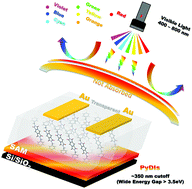Wide band gap pyromellitic diimides for photo stable n-channel thin film transistors†
Abstract
This study reports two novel n-channel pyromellitic diimide (PyDI) derivatives, PyDI-BOCF3 and PyDI-BSCF3, with particularly wide energy gaps of 3.56 eV and 3.49 eV in the solid state, respectively, which induce the investigations of their charge transport properties, photostabilities and thin-film transparency of organic field-effect transistors (OFETs) in this work. Although PyDI-BOCF3 and PyDI-BSCF3 exhibit similar two-dimensional (2D) lamellar packing motifs, PyDI-BSCF3 demonstrates stronger electronic couplings than those of PyDI-BSCF3, suggesting it may show better electrical performance in OFETs. As predicted, PyDI-BSCF3 shows an electron mobility of 0.09 cm2 V−1 s−1 at a deposition temperature of 70 °C in ambient air, which is higher than the electron mobility of 0.058 cm2 V−1 s−1, obtained for PyDI-BOCF3. In contrast, PyDI-BOCF3 exhibits better thermal stability of mobility, which was maintained at ∼0.056 cm2 V−1 s−1 after increasing the deposition temperature from room temperature (RT) to 70 °C. More importantly, it is worth mentioning that the wide energy gaps of PyDI-BOCF3 and PyDI-BSCF3 lead to excellent photostability in OFETs at illumination conditions and optical transparency in the visible range even better than that of DPh-BTBT thin films on transparent glass and flexible PET substrates.



 Please wait while we load your content...
Please wait while we load your content...